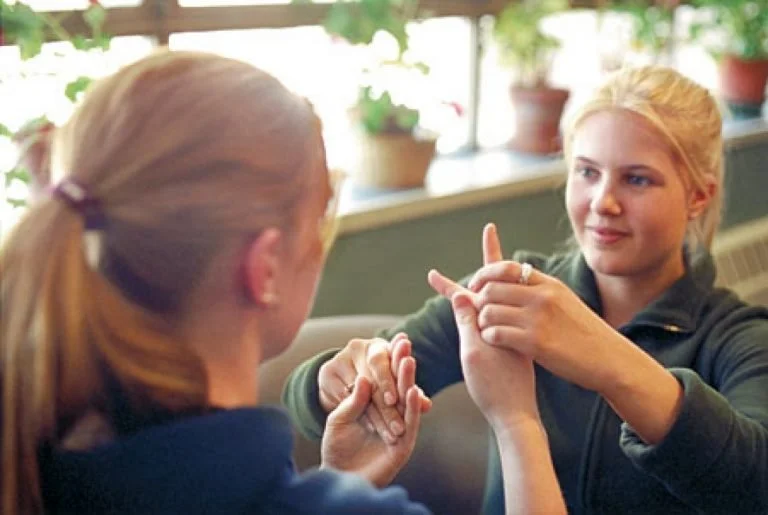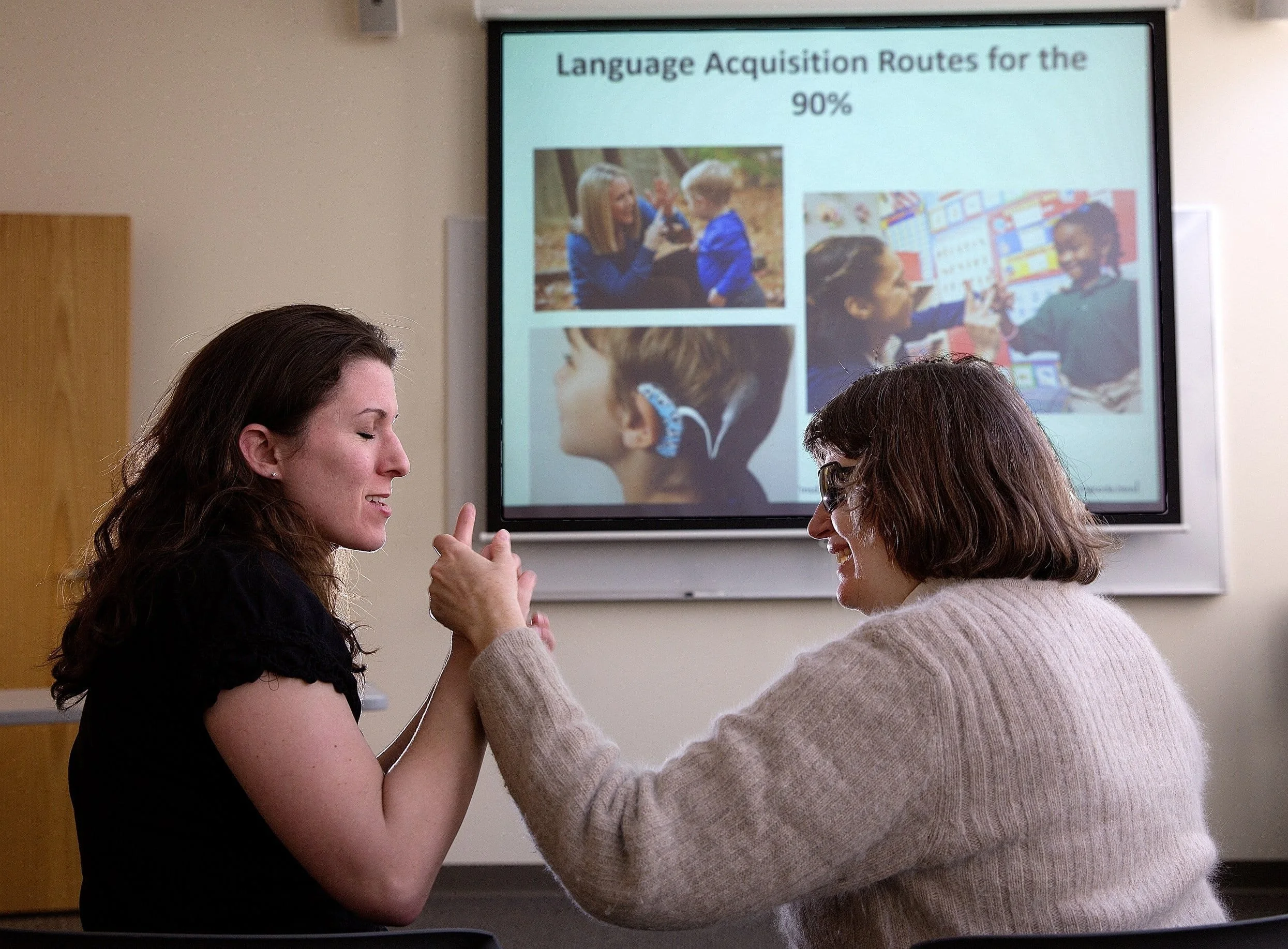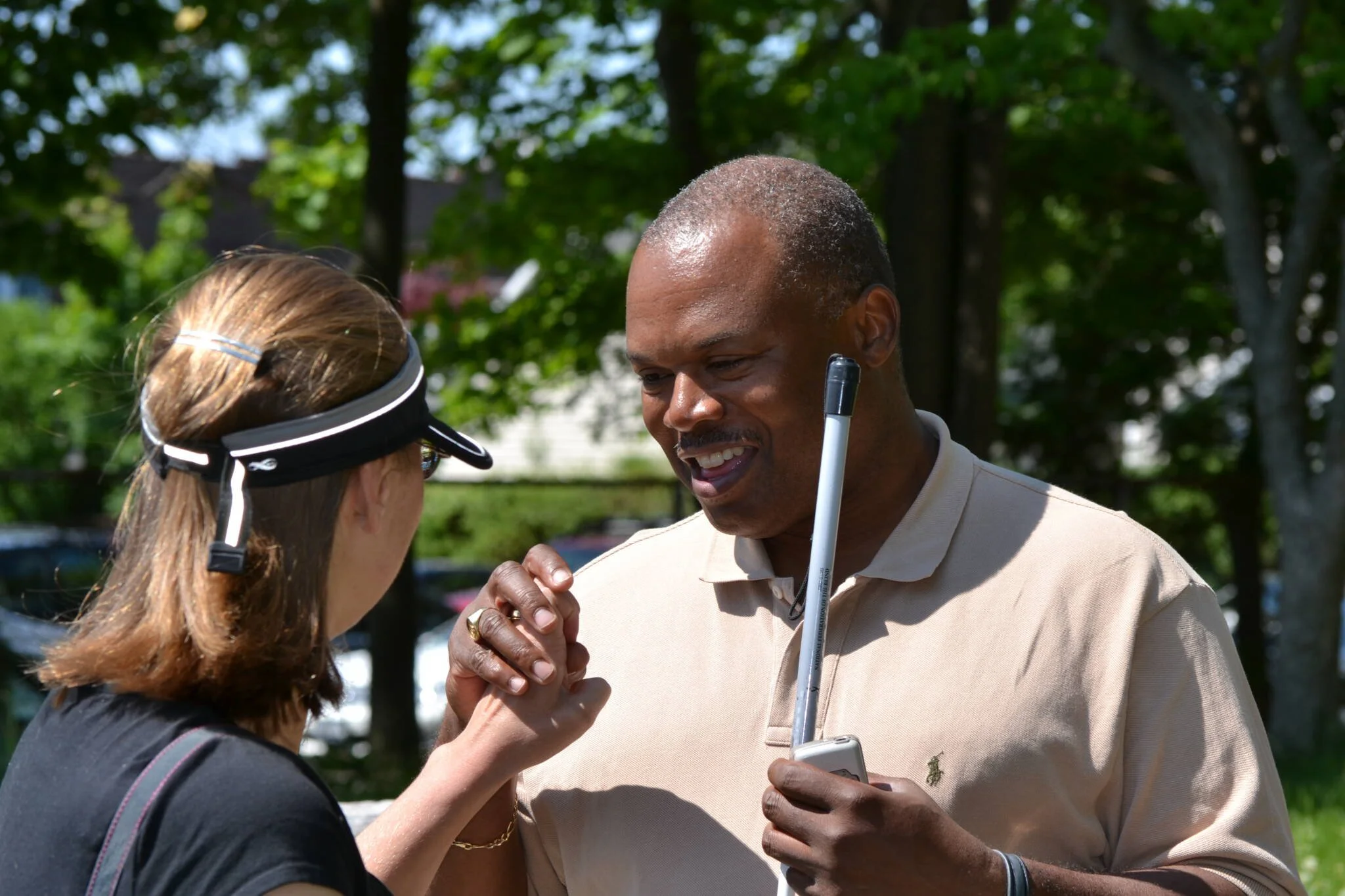Access, Autonomy, and Advocacy: A Look at the DeafBlind Community
A Support Service Provider communicates with her DeafBlind client through Protactile communication. Photo from World Federation of the DeafBlind.
People who are DeafBlind are individuals with both vision and hearing loss. Because they live in a world that functions primarily on sight and sound, they are some of the most resilient, creative, and determined people in the broader disability rights movement. Their lived experiences challenge us to reimagine how we can build an inclusive society based on accessibility, innovation, and empowerment.
The fact is, people with dual sensory loss can live independent and fulfilling lives, with some assistance. The champions here are Support Service Providers (SSPs). Far more than aides, SSPs facilitate autonomy, access, and dignity by being the eyes and ears for a DeafBlind person. SSPs are not case managers or caretakers, they are companions and guides that enable a DeafBlind person’s full participation in life.
Who Is the DeafBlind Community?
A DeafBlind woman communicates with an SSP using their hands.
DeafBlindness is not a singular experience. It exists on a spectrum. Some individuals are born with both hearing and vision loss. Others lose one or both senses later in life through illness, age-related conditions, or syndromes like Usher Syndrome, a rare, inherited disorder characterized by both hearing loss and vision loss.
According to the Helen Keller National Center, approximately 2.4 million Americans live with some degree of combined hearing and vision loss. The National Center on Deaf-Blindness (NCDB) tracks more than 10,000 children and youth with DeafBlindness in the U.S., though adult numbers remain difficult to track due to underreporting and inadequate census data. Steps are being taken by the DeafBlind community to address this data gap through legislation, discussed later in this article.
Why SSPs Matter
For someone who is DeafBlind, daily tasks like going to the grocery store, attending a community event, or even navigating public transportation can be challenging without the right support. SSPs help DeafBlind individuals move through the world on their own terms. They relay visual and auditory information, guide with respect, and communicate through tactile or visual sign language, print-on-palm, and other adapted methods.
SSPs do not speak for DeafBlind individuals. They amplify their independence by enabling them to speak for themselves. Protactile language is a tool SSPs and DeafBlind individuals use to communicate. Developed by DeafBlind individuals themselves, Protactile uses touch, movement, and shared physical space to hold conversations. It isn't a variation of American Sign Language or a workaround for sensory loss. This entirely new way of communicating happens through tactile signals and movement cues like tapping, swiping, or squeezing, having the conversation be embodied. The speaker and listener are fully engaged, in sync mentally and physically.
A person types into a braille notetaker
Other primary communication methods include tactile American Sign Language (ASL), where signs are formed directly on the hands of the DeafBlind person. Another common technique is print-on-palm, where the SSP spells out words by tracing letters on the client’s palm with their finger. For those who read Braille, SSPs may use Braille notetakers or refreshable Braille displays that convert digital text into tactile Braille.
SSPs also use physical objects or communication cards with raised symbols to assist with everyday conversations, especially when quick, simple communication is needed. Technology plays a role, too. Smartphones and tablets equipped with speech-to-text apps, screen readers, or magnification tools help facilitate real-time interaction.
When it comes to mobility, SSPs guide DeafBlind clients using specialized human guide techniques that include tactile cues to signal changes in terrain, obstacles, or directions. They describe environments through touch and verbal explanations adapted to the client’s preferred communication style. Some SSPs help clients use GPS-enabled devices with accessible features to travel more independently. Tactile alerts or vibration signals are also used to notify DeafBlind individuals of sounds like alarms, phone calls, or doorbells.
Beyond tools and technology, SSPs offer crucial social and emotional support. They have the cultural competence to assist DeafBlind people engage in social settings, clarify social cues, and ensure their clients feel included and connected.
Together, these tools and methods allow DeafBlind individuals to communicate, move, and participate more fully and independently in daily life
Mental Health Challenges in the DeafBlind Community
Research shows that DeafBlind individuals are at a higher risk for mental health issues, including depression, anxiety, and social isolation. A 2017 report revealed that nearly 62% of DeafBlind individuals studied had been diagnosed with a mental disorder. These disorders included mood disorders, anxiety, stress-related disorders, and schizophrenia. The report emphasized that the profound isolation resulting from dual sensory loss can lead to marginalization and discrimination, impacting mental health.
Another global report by the World Federation of the Deafblind (WFDB) highlighted that individuals with DeafBlindness often experience poorer health outcomes and face significant barriers to accessing mental health services.
A DeafBlind man is pictured outside holding a white cane with one hand, and the hand of an SSP in the other. Picture from Hellen Keller Services.
SSPs play a foundational role in mitigating these mental health challenges by facilitating communication, providing environmental information, and assisting with mobility. A study conducted at Western Oregon University compared the quality of life between DeafBlind individuals with and without access to SSPs. The findings revealed that those with SSP support consistently reported higher positive responses regarding their quality of life, indicating that SSPs significantly contribute to improved mental well-being and reduced feelings of isolation.
Sadly, a national survey of mental health service providers found that services for individuals who are DeafBlind are often inadequate, with a lack of qualified interpreters and knowledgeable staff. The survey emphasized the necessity for training social workers and counselors in best practices for working with DeafBlind individuals, including communication methods and cultural considerations.
Opportunities for Greater Social Participation
Only 37.9% of DeafBlind individuals are employed, compared to 72.7% of Deaf individuals without additional disabilities. Access to education is equally imbalanced, with just 22% of Deaf individuals holding a bachelor’s degree as of 2022.
The good news is that where SSPs are available, these gaps narrow. With SSPs, students can navigate campuses with confidence. Job seekers make it to interviews on time. Artists attend gallery openings; activists organize rallies; and parents take their children to the park. SSPs create the opportunity for DeafBlind people to participate more fully in society.
Across the country, organizations like the Helen Keller National Center (HKNC) are offering programs that open up greater independence and opportunity for the DeafBlind community. As the only national program of its kind exclusively dedicated to serving DeafBlind individuals, HKNC offers comprehensive, person-centered training that supports every aspect of independent living. At its New York campus, participants in the Comprehensive Vocational Rehabilitation Program receive customized instruction in orientation and mobility, communication strategies (including tactile sign language), assistive technology, daily living skills, and job readiness.
Youth-focused programs like M~POWER and summer intensives prepare young DeafBlind adults for the transition into adulthood by building skills in self-advocacy, career planning, and community participation. Through its DeafBlind Immersion Experience, HKNC also supports service providers and families with in-depth education on communication systems and environmental modifications. Regional community programs extend this support into local neighborhoods, ensuring that independence isn’t limited by geography.
These programs are about more than skill-building; they’re about independence and inclusion for DeafBlind individuals.
Filling in the Gaps in Colorado
In early 2024, the Colorado Commission for the Deaf, Hard of Hearing, and DeafBlind (CCDHHDB) suspended SSP services due to funding shortages. While community pressure helped reinstate some support, hundreds remain on a long waitlist, up to five years for some. The impact of this gap is not just measured in missed appointments or uncompleted errands, but in the erosion of independence and inclusion. A list of SSPs is available on their website.
Yet even in the face of this challenge, the DeafBlind community in Colorado continues to advocate, organize, and educate. Statewide coalitions are working toward long-term legislative solutions, and public testimonies have drawn attention to the essential role SSPs play in mental health, employment, and social engagement.
Not all news is bad in Colorado for the DeafBlind community. A powerful initiative is quietly changing the lives of DeafBlind children and youth. The Colorado Services for Children and Youth with Combined Vision and Hearing Loss Project is a program designed to give DeafBlind children a better chance and living happy, fulfilled lives with opportunities for growth and success.
A little boy who is DeafBlind works with his teacher. Image from the Perkins School for the Blind.
Since October 2023, this state-backed effort has been expanding to find young people navigating the complex world of combined vision and hearing loss. Early identification is key to catching Deafblind children’s needs quickly, opening doors to learning, communication, and connection, before foundational developmental windows close.
And this project goes beyond the kids themselves. It understands that families are the heart of support. That’s why it offers training, resources, and a community where parents and caregivers can learn, share, and find strength in one another. For educators and service providers, specialized training sharpens their skills, ensuring they’re not just meeting standards but truly meeting needs. By offering these trainings and resources to family members and caregivers, it expands opportunities for DeafBlind kids through further support.
One of the project’s standout efforts is training professional interveners to become vital bridges for DeafBlind students, helping the students access the world around them through communication and guidance. With mentorship and support, many professionals achieve national certification, elevating the quality of support available throughout Colorado.
What Now?
Globally, recognition of the DeafBlind community is growing. Organizations like the World Federation of the DeafBlind are campaigning to make June 27 the official International Day of DeafBlindness. The date of June 27 was chosen to honor of Helen Keller’s birthday. Born June 27, 1880, she remains the iconic figure and role model in the DeafBlind community.
Also on the legislative front, the community is backing the DeafBlind DATA Act (H.R.8859), which would require the U.S. Census Bureau to begin to collect meaningful demographic data on DeafBlind individuals specifically. Currently, big data programs like the Census don’t capture enough detail about people who have both hearing and vision loss. Without that data, it’s challenging to understand the needs and nuances of the DeafBlind community. This act will require the Census Bureau to ask the right questions, make sure DeafBlind people are truly counted, and ensure that policies, funding, and services accurately reflect the community’s needs. The DeafBlind community is diverse, and this Act recognizes that. Collecting accurate data on age, race, location, and other factors will lead to more effective and focused services and solutions.
Even with better legislation and more services, real inclusion needs to include connection and understanding. Underneath the letter of the law, we are working for changes in perception, attitude, engagement, and acceptance. The DeafBlind community has already led the way with innovation, advocacy, and resilience. What they need now is consistent support that honors their autonomy and lived experience.
CPWD is proud to stand alongside the DeafBlind community. Our Independent Living Services help people set their own goals and access the tools they need, from housing and healthcare to communication and mobility support. While Colorado continues to face funding gaps for SSPs, CPWD is here to help fill in where we can, with services rooted in respect, choice, and empowerment.
We believe in a future shaped by DeafBlind voices. A future where no one is left out of the conversation and where connection is possible for all.






